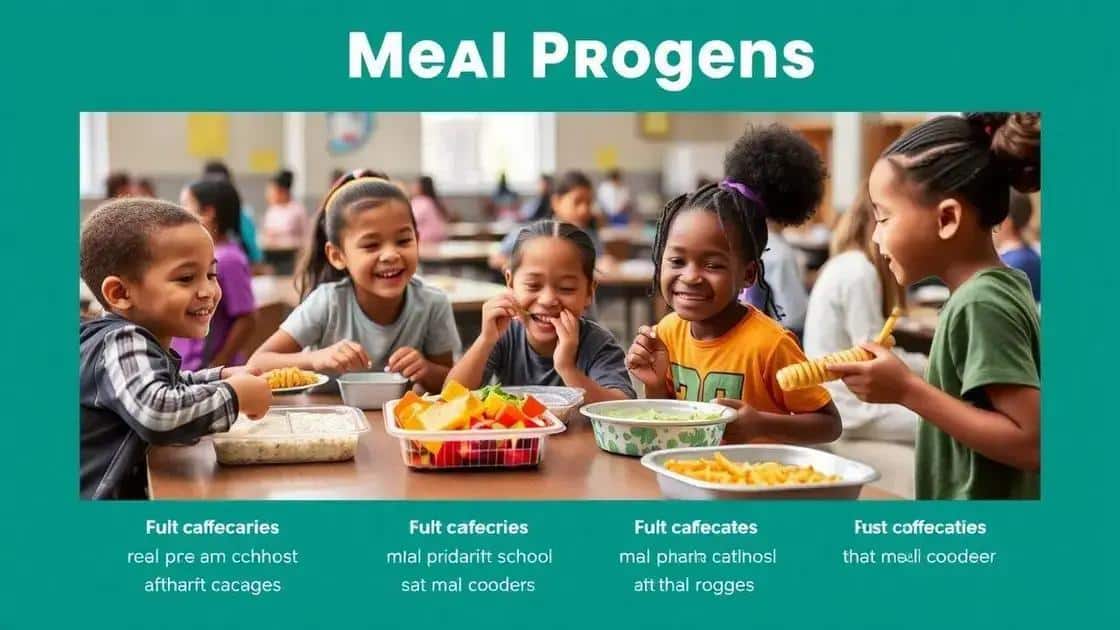Support student meal access: a vital initiative

Support student meal access ensures that all students receive nutritious meals, enhancing their academic performance and overall well-being through community involvement and effective meal programs.
Support student meal access is essential for ensuring that all students have the nutrition they need to thrive academically. But how do we make this a reality? Let’s dive into the various ways meal access can be improved for students from all backgrounds.
Understanding the importance of meal access
Understanding the importance of meal access is crucial for student success. Students need adequate nutrition to focus, learn, and excel in their studies. When students are well-fed, they’re more likely to attend school regularly and participate actively in class.
The role of nutrition in education
Proper nutrition fuels the brain and body. Research shows that students who receive nutritious meals perform better academically. Good food choices support cognitive function and enhance memory.
How access affects learning
When students face food insecurity, it can create obstacles in the classroom. Hungry students may struggle to concentrate, leading to lower grades and academic performance. This can especially impact students from low-income families. Ensuring access to meals can directly influence academic outcomes.
Benefits of meal access
- Improved attendance rates
- Higher academic achievement
- Better mental and physical health
- Stronger community ties
Meal access does not only benefit individual students; it enhances the overall learning environment. Schools with robust meal programs often see a rise in student engagement and participation.
To address these challenges, schools and communities must work together. Efforts like food drives, partnerships with local organizations, and healthy meal programs are essential. Together, we can create a supportive atmosphere where every student thrives and learns without the distraction of hunger.
The impact of nutrition on student performance
The impact of nutrition on student performance is significant. A well-balanced diet not only supports physical growth but also enhances brain function. When students receive proper nutrition, their ability to concentrate and learn improves drastically. Conversely, poor nutrition can lead to fatigue and decreased cognitive abilities.
How nutrition affects learning
Studies indicate that students who consume healthy meals perform better academically. Nutritional deficiencies may hinder their ability to grasp new concepts effectively. This is especially true during critical learning periods, such as during exams and important projects.
Essential nutrients for students
- Proteins: Build and repair tissues; vital for growth.
- Carbohydrates: Provide energy for daily activities.
- Vitamins and minerals: Support overall health and brain function.
- Healthy fats: Essential for brain development.
Each of these nutrients plays a unique role in learning. A diet rich in fruits, vegetables, and whole grains can boost memory and focus. On the other hand, a diet high in processed foods and sugars can lead to energy crashes, impacting classroom performance.
Creating awareness among students and parents about the importance of nutrition is vital. Schools can also play a role by offering nutrition education programs. These initiatives help students make healthier food choices that support their academic success.
Programs supporting meal access in schools

Programs supporting meal access in schools are essential for ensuring that all students receive nutritious food. These initiatives help tackle food insecurity, allowing students to focus on their studies rather than worrying about hunger. Schools play a vital role in providing meals that meet both health guidelines and taste preferences.
Types of meal programs
There are several types of meal programs available in schools. Hot lunch programs offer daily meals, while breakfast programs ensure students start their day with a healthy meal. Additionally, some schools provide after-school snacks or dinner programs. These options vary depending on the resources available and the needs of the student population.
Benefits of meal programs
- Improved academic performance: Students who eat healthy meals are more alert and ready to learn.
- Fostering community: Meal programs can bring families together for events, encouraging social connections.
- Nutrition education: Programs often include lessons on healthy eating, teaching students valuable information.
Moreover, meal programs help reduce stigma for students from low-income families. When all students access free or reduced-price meals, it normalizes the experience and fosters inclusivity. This encourages a supportive school environment where every student feels valued and respected.
Collaboration with local farms and food banks can enhance food quality and variety. Schools that partner with these organizations often provide fresher produce and community-supported food systems. This not only supports local agriculture but also educates students about where their food comes from.
Community efforts to enhance meal programs
Community efforts to enhance meal programs are essential for improving student nutrition. These initiatives bring together local organizations, businesses, and volunteers who share a commitment to fighting food insecurity. By working together, communities can create sustainable solutions that benefit students and families.
Types of community initiatives
Many organizations contribute to meal programs through various initiatives. Food banks often work with schools to provide extra supplies. Local farms may donate fresh produce to enhance the quality of meals. Additionally, community groups might organize fundraising events to support these meal programs financially.
Benefits of collaboration
- Stronger support systems: Community involvement fosters a network of support for families in need.
- Increased resources: Combining efforts allows for more food options and better meal quality.
- A sense of belonging: Engaging with community members creates connections that enhance student morale.
Partnerships between schools and local businesses can also lead to sponsorship opportunities. Local restaurants may provide meals for special events, showcasing their commitment to student health. This not only supports meal access but also benefits local economies.
Moreover, schools can host food drives or community meals, inviting parents and students to participate. These events can help raise awareness about nutrition and the importance of accessible meals. Engaging the community in such activities can lead to increased support and volunteers for meal programs, ensuring that no child goes hungry.
Ways to advocate for better meal access
Ways to advocate for better meal access are vital in ensuring that all students receive the nutrition they need. Advocacy can take many forms, from raising awareness to actively participating in policy changes. Engaging with local community members and organizations can help create a strong support network.
Getting involved in local initiatives
Start by connecting with food banks, schools, and community groups focused on meal access. Volunteer your time or resources to help organize events or distribute food. When community members come together, they can create powerful change.
Using social media for awareness
Social media platforms can be effective tools for advocacy. Sharing statistics about food insecurity and promoting local meal programs can raise awareness. Create engaging posts that highlight the importance of meal access and encourage followers to get involved.
Engaging with policymakers
- Contact local representatives: Reach out to your city officials or school board members to express your concerns about meal programs.
- Attend community meetings: Participate in discussions about public resources and voice the need for better meal access.
- Support policy changes: Advocate for legislation that increases funding for school meal programs.
Building relationships with local leaders can enhance efforts to improve meal programs. Coordinating meetings with policymakers ensures that student needs are being heard at all levels. Providing testimonials about how meal access has positively impacted students can also drive change.
Finally, inspiring others to join the cause is crucial. Educating friends and family about the importance of meal access can amplify advocacy efforts. Together, communities can work towards solutions that ensure every student has the necessary nutrition to succeed.
In conclusion, advocating for better meal access is essential for the well-being of students. Communities can come together, engage with local leaders, and raise awareness about the importance of nutrition. By working collectively, we can create a supportive environment that ensures every student has access to healthy meals. Together, we can make a significant impact and help students thrive academically and personally.
FAQ – Frequently Asked Questions about Student Meal Access
What is meal access for students?
Meal access refers to the ability for students to receive nutritious meals through school programs, helping to combat food insecurity.
How can communities support meal access?
Communities can support meal access by volunteering at local meal programs, organizing food drives, and advocating for local policies that improve nutrition.
What are some benefits of providing healthy meals in schools?
Healthy meals improve students’ concentration, boost academic performance, and promote better physical and mental health.
How can I get involved in advocating for better meal access?
You can get involved by reaching out to local representatives, participating in community events, and raising awareness on social media about the importance of meal access.





